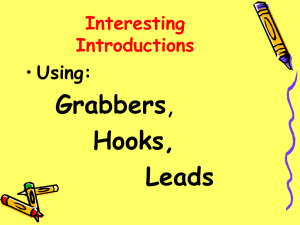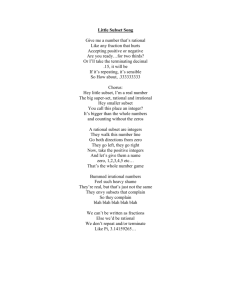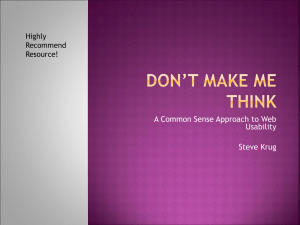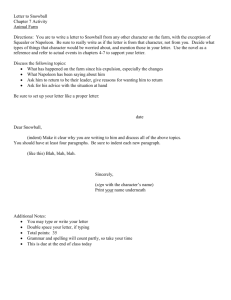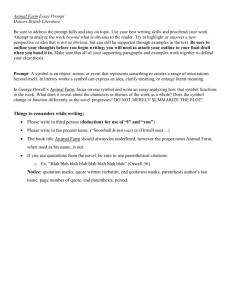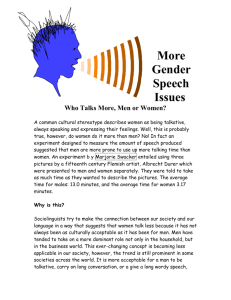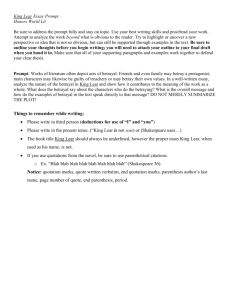Career Day Speaker Tips
advertisement
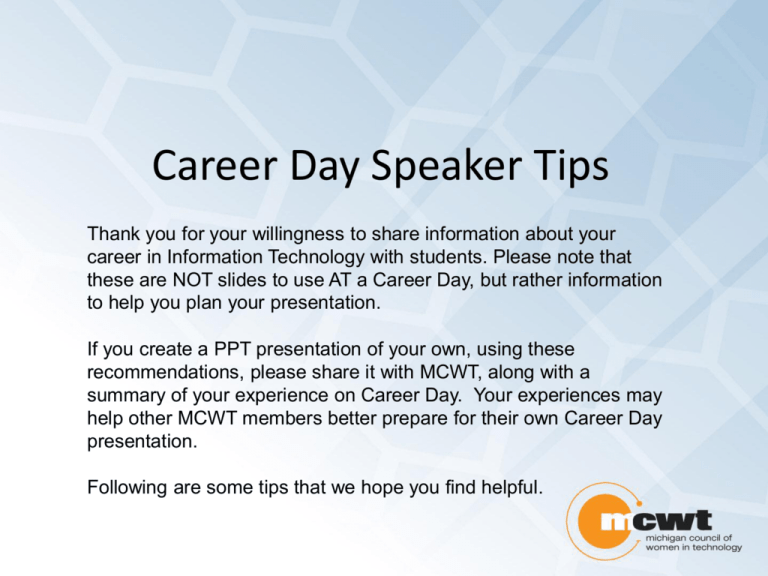
Career Day Speaker Tips Thank you for your willingness to share information about your career in Information Technology with students. Please note that these are NOT slides to use AT a Career Day, but rather information to help you plan your presentation. If you create a PPT presentation of your own, using these recommendations, please share it with MCWT, along with a summary of your experience on Career Day. Your experiences may help other MCWT members better prepare for their own Career Day presentation. Following are some tips that we hope you find helpful. In Advance of the Day • Decide if you’ll need any equipment (white boards, microphone, podium, computer – some of these will depend on the size of the student group, of course) or technology set-up (LCD projector, wireless internet connection). Alert the teacher well in advance. At many schools, these items aren’t always easy to come by. Most schools recommend that you bring your own computer equipment. • Prepare visual aids! Your audience will be more engaged. • Prepare handouts or take-aways. Consider passing around example tools of your trade or leaving students with take-home materials that will stimulate conversation with their families. • Arrive early to test the equipment. Something always needs tweaking. It’s a rule. Schedule from a local H.S. STEM Career Day offers an illustration for you to anticipate a potential schedule for the event 3:00-3:25 Introduction Meeting for the students 3:30-4:00 Break Out Session #1 4:05-4:35 Break Out Session #2 4:40-5:10 Break Out Session #3 5:10-5:40 Break Out Session #4 5:40-6:00 Clean Up and any follow up questions from students. The STEM students will be given a pamphlet describing the speakers and their room number during the introduction meeting. They will then choose out of the 25 or so speakers who they would like to listen to. It is the role of the speaker to take 15 -20 min during each break out session to discuss their schooling and what their daily responsibilities are in their field.* Then leave the last 10 min for questions and answers. Each speaker will have to speak 4 times...this allows the students to rotate and investigate several avenues. *See slide 8 “Road Map” for more suggestions on what to say about your job Know your audience. Are you speaking to: • • • • • A co-ed group or just girls? Pre-teens or teens? The whole class or a segment of students who chose to hear about your particular career cluster? Students with high-achieving parents or with parents who struggle? Students who can afford a 4 year degree or those who need alternatives to a university approach to an I.T. career? Students of any age and gender are as diverse as any group of individuals, yet some traits tend to be common among them, namely… Displaying outward confidence while feeling inwardly less secure Appreciative of anecdotes and stories that humanize you Where did you grow up? What did you want to be when you were their age? Appreciate of anecdotes and stories that personalize the facts Easily bored with one-way communication Could tune-out completely if presented with too much industry jargon or acronyms Questioning and seeking proof; more willing to challenge authoritative statements than you would think Anxious about the next phase of their lives When you arrive • If appropriate, stand at the door and greet students as they enter. Many are shy. You might be, too. If they (you) have to make that personal connection to you early, it will help them (you) make eye contact and stay engaged during your presentation. • Ask for a volunteer to take 3 or 4 photos of you during your presentation. (If you spot a loud student early on, pick that one! It will keep him/her occupied and, hopefully, out of trouble.) If possible, ask that the student taking the photos include your PPT slides (if any) in the background. If you have enough time to do an activity, ask that photos be taken during the activity as well. Tips for speaking to kids in grades K-6 (It might work for bigger kids, too!) These 2 tips are from a former teacher and public speaker who has spoken many times to middle school students: If you are planning to ask ANY questions that require them to raise their hands, warn them at the beginning of your presentation. If you expect audience participation, set the expectation early on. If the audience is young, do a practice question. For example, ask them who rode the bus to school. Then express skepticism. Say, “I think some of you are too shy and didn’t raise your hand. Let’s try again.” Then ask again, “Who rode the bus to school?” Now they are warmed up and ready to raise their hands to future questions. Grade school audience: Tell them you want them to practice clapping. Say, “Ready? Let’s hear it.” Then tell them it wasn’t loud enough. Tell them you want the kids in the next room to wonder what the heck is going on in OUR room! “Ready? Let’s hear it again!” This exercise helps them get focused on you. If appropriate, do something during the presentation that invites applause. They’ll be ready. They may even clap for you at the conclusion of your Career Day presentation! Road Map – What To Say • • • • • • • • • • • • • • What do you do? What did you do before this? What kinds of things do you do at your job? Did you have to go to school after high school? What kinds of subjects did you like to study in school? What kinds of subjects were important for you to know in order to be able to do your job? Do you like your job? Did you always know you wanted to do what you do? If not, how’d you start out? How did you get to where you are? Was your path typical/not typical? What might you do differently if you started over or were “in these kids’ shoes?” What do you enjoy most/least about your work? Do you travel for work? Where have you been that is cool? What is a typical work day for you? What is the projected job market? Describe your work environment. Sample Question Formats • • • • • • • Let’s have a show of hands. How many of you think/agree...? Can anyone give me an example of…? How many of you have/think/agree with…? Who knows/has ever experienced/appreciates…? Can anyone tell me what (blah blah blah) means? What do you think is the most interesting….? Under what circumstances do you think (blah blah blah) happens/is necessary? • Can you think of a reason/possibility when…? • Does …(blah blah blah) … sound familiar to any of you? • How many of you own a …? You’ll have competition to be cool! Other speakers may intrigue the students because of the “cool factor.” Coolness can’t be overrated! You can use cool activities to overcome the seeming lack of cool in I.T. careers. These career paths could be speaking the same day: • A bee keeper • A mobile vet lab • A SWAT team member • A mounted policeman • Loads of firemen • Action film-maker Cool Comments • • • • • • • • Tell them that many IT people work from home. Many IT people work via video conferences. Mention Skype; they’ve heard of it and have probably used it. Before those conferences, many IT people have to change out of their pajamas. (That is so cool!) Tell them computers are stupid (or dumb). Younger kids will love that you used a 'bad' word. IT people give computers instructions to tell them what to do. We call those instructions 'code.‘ Similarly, a LEGO could be called stupid. Both need humans to make them work. Many things in our lives are either computers in disguise, or contain computers. Gaming consoles, phones, MP3 players, TVs, and even cars and dishwashers use code. Being good at math is a plus, but you could tell them you know many developers who aren't strong at math who are great developers. What you need to be good at is breaking down a problem into parts, and being able to solve those parts. Being good at writing and communication is surprisingly a plus. The IT field needs more developers who can write coherently and can work as part of a team. If you know anyone who has worked on some famous video game programming, mention it. If you’ve ever met someone famous in IT, mention it. If you’ve ever done something really cool at your job, mention it. Activities – Choose one of these suggestions that is ageappropriate and time-appropriate. Students love activities! NOTE: If you create an activity, and it works well, be sure to share it with MCWT. We’ll add it to this list. • • • • • Give the students a plain Bic pen (or a pen that unscrews) and ask how many ways they can think of to use it or its components that aren’t related to its primary use. (A major IT corporation uses this during job interviews as a test of creativity!) Compare it to a job in I.T. Step them through making an algorithm for making a paper airplane. Apart from the "naughty" factor about making and flying a paper airplane in class, it shows how you have to map real world to code. Be sure to bring the paper for the airplanes. Decide in advance if you want all the students to make a plane or ask for volunteers to be the guinea pigs at the front of the room. Illustrate coding by doing the number guessing-game provided on slide 11. (Note: check the code in advance; make sure it works; get comfortable with it.) Make your computer talk to the class. Suggestions provided on slide 12. Create a true/false quiz or a contest. Bring a prize! Activity: Number guessing game H/T Katie Fulton Cunningham Activity: Make your computer talk If you can make your computer speak, this could be, handsdown, the best trick. You may think a bunch of kids who had consoles and computers at home that spouted voice acting all the time wouldn't be into this, but they will be amazed. Expect requests to do everyone's names, get the computer to sass you, and get it to say bits of songs that you may not be cool enough to recognize. (Admit your ignorance on that one!) For K-8 Audience Some things may take you by surprise if you’re not prepared. Here are a few: • • • • The kids repeat questions. Over and over and over again. Not variations on a question: the same exact question. Keep answering it with a smile. The teacher will usually intervene. Many students, even at this age, have a smart phone. Some school districts passed a technology millage and have given tablet computers to all students, including Kindergarteners. They will ask what video games you play. If it’s not your thing, be sure to play a few before your Career Day presentation, so that you can sound knowledgeable about things the kids care about. The more games you can name, the more they will experience shock and awe at your coolness. Other questions you may be asked: • • • “Do you know anyone who works on video games?” “How long does it take you to make a website?” (Answer: It depends. Some sites may take a day, while others may be a group project that could take up to a year. ) “Can you hack into our school’s computer? “ (Answer: No. That’s illegal. But some companies hire hackers to try to break into their own company’s computers in order to test their security systems. That is legal.) For High School-Age Audience What do you need to know before you enter this field? Considering the diversity and range of the technology industry, here are some important things to know about the technology field. • Good salaries • Smart colleagues • Three paths to a career in IT: (Note: MCWT has supporting materials on the parent/teacher resources pages under www.mcwt.org, please check for availability of the documents.) • • • 4 year degree Community College degree or certificate IT training during a Military career For Any Grade Level Audience IT Career Scavenger Hunt Note: Requires internet access and computers for the students Here’s a twist on an old-time favorite – the scavenger hunt. Instead of the hunt being for odds and ends around the neighborhood, this one is for IT careers on the Internet. Instruct them to go to any company’s website, so long as the company is tech-related. Find its link to “Careers” or “Jobs” at the company. Call on students to read the job description of something that sounds interesting and IT-focused. If you’re worried about something unexpected showing up, then plan in advance. Have 5 URLs ready to go that you’ve reviewed to see what its job openings are. Alternate Idea – No computers required Several days before your Career Day commitment, explore the job postings of several IT-related companies. Paste the job descriptions onto a PPT slide. Be sure to identify the company. Include jobs that could be considered “cool,” but also include descriptions that would appeal to the more serious math-focused students. Statistics: Job Opportunties in I.T. • 1.4 million I.T. jobs available by 2020 • We can only fill 6 out of 10. • If the job requires a Bachelor’s or advanced degree, we can only fill 3 out of 10. • IT occupations are more stable and pay better than other jobs. • Only 18% of computing and information sciences degree recipients are female, so companies are always looking for women to hire in I.T. Advice for you to give students 1. Try new things - you may find that you like it and are even good at it! 2. Don't let anyone tell you that you can't do something just because of who you are (a girl, for example!). Stubbornness can be a good thing! If someone tells you that you "can't" do something well, it should just make you want to prove them wrong! 3. Find something that you are passionate about, and go for it. If people can tell you really care about what you are doing and are excited about it, they will want to help you. And if you are working for something you love, you won't mind working hard to reach your goal. 4. Don't be scared to ask for help - it doesn't make you look bad. It just shows that you want to learn. Credits and Resources • Katie Fulton Cunningham http://therealkatie.net/blog/2012/oct/24/career-day/; used with permission • Bureau of Labor Statistics • More info: A number guessing game can be implemented with a 'fake programming language' such as Scratch: http://scratch.mit.edu/projects/emres/2859373 • Article: “Teach children planning and problem solving not programming” http://shape-of-code.codingguidelines.com/2012/09/20/tea... • Write games that can be played on an Xbox 360. Students can get access to it all for free via dreamspark.com Check out http://msdn.microsoft.com/en-us/centrum-xna.aspx for more information. • http://ask.reference.com/related/What+Should+I+Discuss+at+Career+Day?o=101994&qsrc=2892&l=dir • “How to give an effective presentation” http://network.nature.com/groups/naturejobs/forum/topics/9865 This link gives advice on creating an effective Career Day presentations • This links to a great Career Day slide share created for a presentation about a career in Journalism. It shows humor, easy-toread slides, and other good things to imitate. http://www.slideshare.net/cmprice/2012-career-day-presentation-12657362 • This links to a math teacher’s Career Day slide share. It’s got a nice visual about income possibilities for the career. It also offers a list of suggested questions to cover. http://mathequality.wordpress.com/2013/07/11/career-day-my-one-slidepresentation/ • MCWT website http://www.mcwt.org/Parent__Teacher_Resources_188.html
